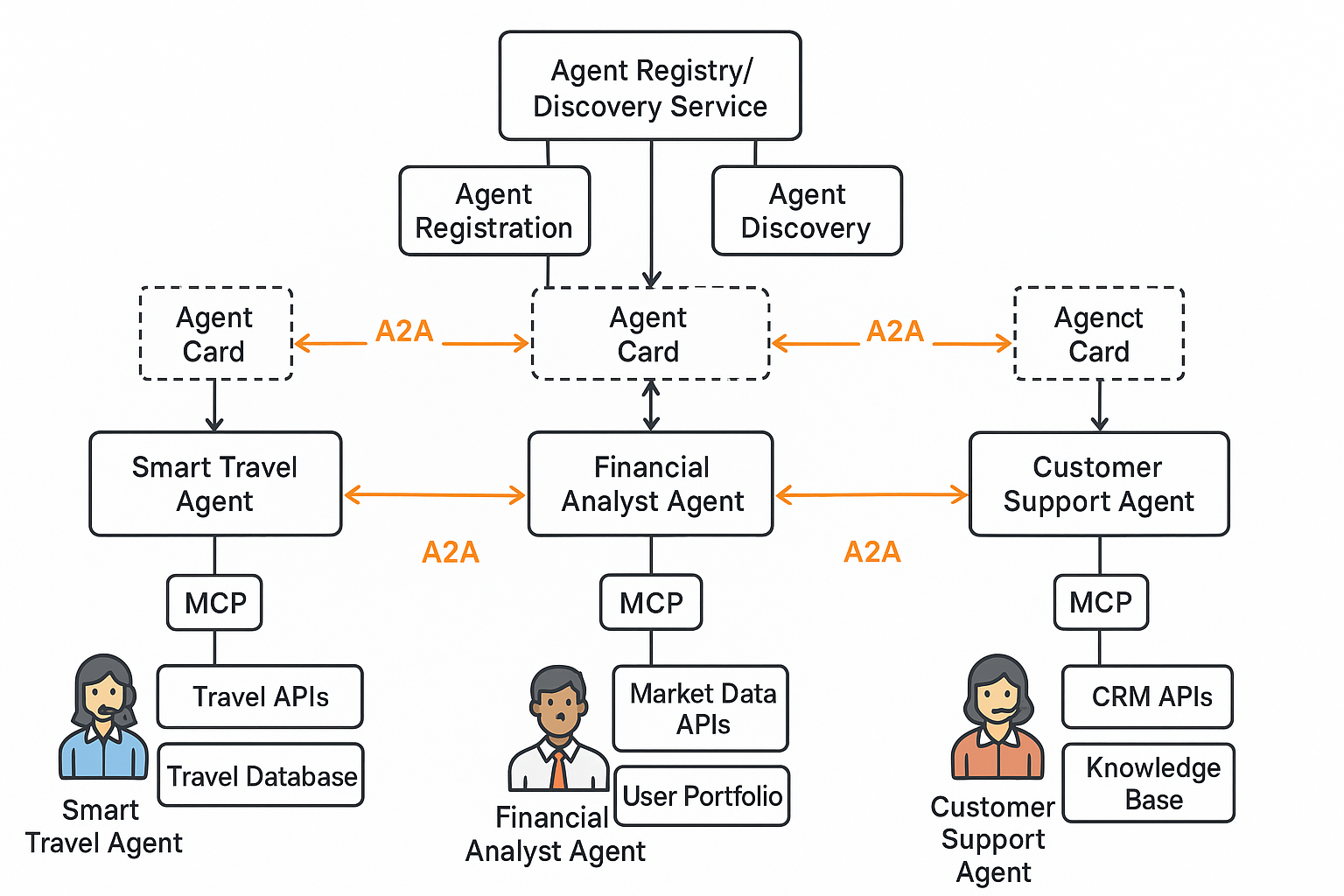Introduction
The buzz around AI agents is electrifying. We're envisioning a future populated by intelligent entities collaborating to solve complex problems, automate tedious tasks, and generally make our digital lives more seamless. But how do these agents talk to each other? How do they find the right collaborator for a specific task?
Communication Protocols
In the evolving landscape of AI agent communication, several protocols have emerged to facilitate interoperability and collaboration among autonomous agents. IBM’s ACP supports task delegation within local clusters via JSON-RPC, while China’s ANP uses DIDs for decentralized agent discovery. Agora offers a meta-protocol for scalable, natural language-based interactions, and Wildcard’s agent.json defines lightweight agent schemas. Eclipse’s LMOS supports diverse message patterns, and Near AI’s AITP enables structured, cross-boundary transactions.
Google’s Agent-to-Agent (A2A) protocol, backed by 50+ partners, offers a standardized, peer-to-peer framework for agent discovery, authentication, and capability invocation via HTTP and JSON-RPC. Unlike ACP’s platform-specific design, A2A supports cross-vendor interoperability, enabling collaboration across diverse agent frameworks. While protocols like AITP focus on structured transactions, A2A prioritizes horizontal scalability and decentralized communication. Its open, interoperable approach makes A2A a key foundation for building a dynamic, connected, and efficient agent-driven internet.
What is the Agent 2 Agent Protocol?
At its core, an A2A protocol defines the rules and formats for communication between autonomous AI agents. It's not a single monolithic standard but rather a set of principles and specifications that enable seamless interaction. Key aspects of an A2A protocol typically include:
- Message Format: Defining the structure and content of messages exchanged between agents. This could involve standardized formats like JSON or Protocol Buffers, ensuring that agents can understand each other's requests and responses.
- Communication Channels: Specifying the underlying transport mechanisms. This could range from direct API calls and message queues (like RabbitMQ or Kafka) to peer-to-peer networking protocols.
- Discovery Mechanisms: Outlining how agents can find and identify other agents with specific capabilities or resources. This is crucial for forming collaborative relationships.
- Security and Authentication: Establishing methods for verifying the identity of agents and ensuring secure communication.
- Negotiation and Task Allocation: Defining protocols for agents to negotiate terms, delegate sub-tasks, and manage workflows collaboratively.
- Error Handling and Reliability: Specifying how agents should handle communication failures and ensure the reliability of their interactions.
The Agentic Mesh: A Network of Collaboration
The true power of A2A protocols shines when we consider the concept of an agentic mesh. This is a decentralized network where numerous autonomous agents can register their capabilities, discover other relevant agents, and collaborate dynamically to achieve complex goals.
How A2A Fuels the Agentic Mesh
The A2A protocol is the lifeblood of a thriving agentic mesh in several key ways:
- Registration and Discovery: A clear A2A protocol lets agents advertise their skills (e.g., summarizing, analyzing data, booking flights) to a registry or via discovery tools. Other agents can then locate and use these services, avoiding hardcoded links and supporting dynamic discovery.
- Seamless Communication: Standardized message formats and channels allow agents to interact regardless of their design, enabling interoperability essential for complex, multi-agent workflows.
- Dynamic Collaboration: With discovery and communication in place, agents can team up temporarily for tasks. For example, a report-writing agent may find others for research, formatting, and visuals to finish the job efficiently.
- Scalability and Resilience: A decentralized agent mesh using A2A protocols scales easily and handles failures well. New agents can join, and existing ones can take over tasks without major disruption.
- Ecosystem Growth and Innovation: A standard A2A protocol supports a growing ecosystem. Developers can build niche agents, confident they'll integrate smoothly with others, fuelling innovation and advanced solutions.
The Foundation: Agent Registration and Discovery with Agent Cards
For an agentic mesh to truly flourish, agents need a way to announce their presence and capabilities, and other agents need a mechanism to find them. This is where agent registration and discovery come into play, often facilitated by the exchange of Agent Cards. Think of an Agent Card as a digital business card containing essential information about the agent, such as:
- Agent Identifier: A unique ID for the agent.
- Capabilities: A clear description of what the agent can do (e.g., "summarize documents," "translate languages," "control smart lights"). These capabilities might be described using a standardized vocabulary.
- Communication Endpoints: The network addresses and protocols the agent uses for communication (e.g., specific API endpoints, message queue details).
- Metadata: Additional information like the agent's version, status, security credentials, or even quality of service indicators.
Discovery in Action:
The A2A infrastructure serves as a directory or distributed system that stores and indexes Agent Cards. When an agent needs a capability, it queries this system to find matching agents based on their advertised skills.
In an agentic mesh with a Smart Travel Agent, Financial Analyst Agent, and Customer Support Agent, each publishes its Agent Card upon registration with the discovery service.
- The Smart Travel Agent, needing travel insurance insights, queries the registry for financial analysis capabilities.
- The registry matches and returns the Financial Analyst Agent based on its Agent Card.
- Using the contact info from the card, the Smart Travel Agent initiates communication via A2A to request insurance options.
- Similarly, for booking-related questions, it can find and contact the Customer Support Agent using A2A and the registry.
Together, A2A protocols, Agent Cards, and discovery services enable fluid collaboration among agents. Each uses MCP to access its tools and data, while A2A manages inter-agent communication for complex workflows.

Conclusion
While the vision of a fully realized agentic mesh is still evolving, the development and adoption of robust A2A protocols are critical steps. Challenges remain in areas like standardization, security, trust, and governance. However, the potential benefits – a future where intelligent agents work together seamlessly to solve complex problems and augment human capabilities – are immense.
Visit Quasar to know more.

Siddharth Vidhani is an Enterprise Architect in Digital Engineering of Coforge Technologies. He has more than 19 years of experience working in fortune 500 product companies related to Insurance, Travel, Finance and Technology. He has a strong technical leadership experience in the field of software development, IoT, and cloud architecture (AWS). He is also interested in the field of Artificial Intelligence (Machine Learning, Deep Learning - NLP, Gen AI, XAI).
Related reads.
About Coforge.
We are a global digital services and solutions provider, who leverage emerging technologies and deep domain expertise to deliver real-world business impact for our clients. A focus on very select industries, a detailed understanding of the underlying processes of those industries, and partnerships with leading platforms provide us with a distinct perspective. We lead with our product engineering approach and leverage Cloud, Data, Integration, and Automation technologies to transform client businesses into intelligent, high-growth enterprises. Our proprietary platforms power critical business processes across our core verticals. We are located in 23 countries with 30 delivery centers across nine countries.



